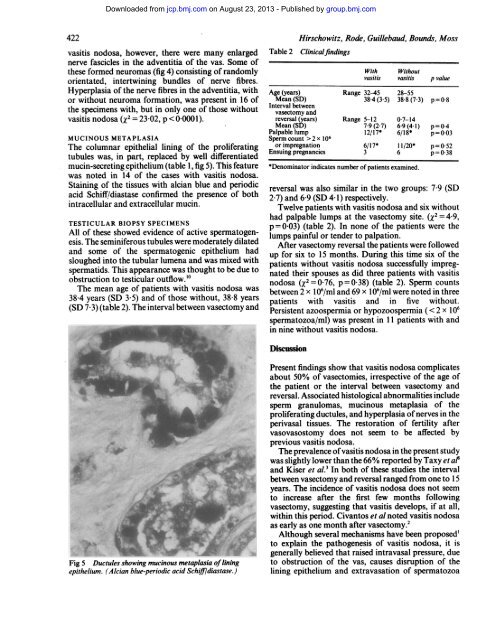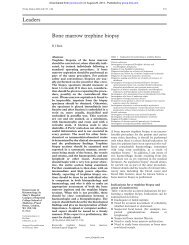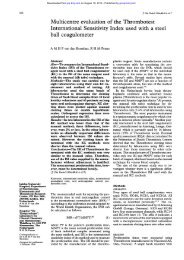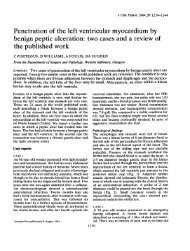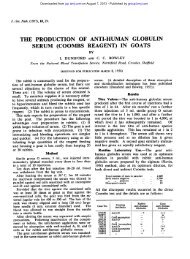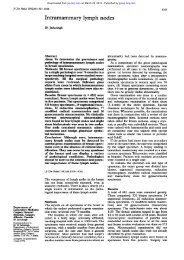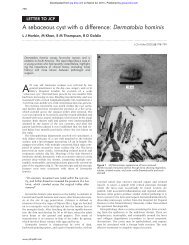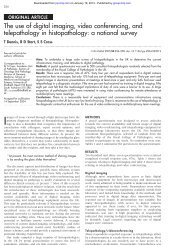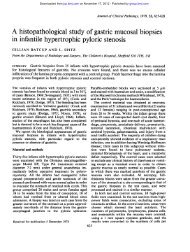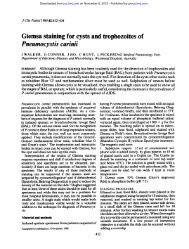Vasitis nodosa and associated clinical findings - Journal of Clinical ...
Vasitis nodosa and associated clinical findings - Journal of Clinical ...
Vasitis nodosa and associated clinical findings - Journal of Clinical ...
You also want an ePaper? Increase the reach of your titles
YUMPU automatically turns print PDFs into web optimized ePapers that Google loves.
Downloaded from jcp.bmj.com on August 23, 2013 - Published by group.bmj.com<br />
422<br />
vasitis <strong>nodosa</strong>, however, there were many enlarged<br />
nerve fascicles in the adventitia <strong>of</strong> the vas. Some <strong>of</strong><br />
these formed neuromas (fig 4) consisting <strong>of</strong> r<strong>and</strong>omly<br />
orientated, intertwining bundles <strong>of</strong> nerve fibres.<br />
Hyperplasia <strong>of</strong> the nerve fibres in the adventitia, with<br />
or without neuroma formation, was present in 16 <strong>of</strong><br />
the specimens with, but in only one <strong>of</strong> those without<br />
vasitis <strong>nodosa</strong> (x2 = 23-02, p < 0-0001).<br />
MUCINOUS METAPLASIA<br />
The columnar epithelial lining <strong>of</strong> the proliferating<br />
tubules was, in part, replaced by well differentiated<br />
mucin-secreting epithelium (table 1, fig 5). This feature<br />
was noted in 14 <strong>of</strong> the cases with vasitis <strong>nodosa</strong>.<br />
Staining <strong>of</strong> the tissues with alcian blue <strong>and</strong> periodic<br />
acid Schiff/diastase confirmed the presence <strong>of</strong> both<br />
intracellular <strong>and</strong> extracellular mucin.<br />
TESTICULAR BIOPSY SPECIMENS<br />
All <strong>of</strong> these showed evidence <strong>of</strong> active spermatogenesis.<br />
The seminiferous tubules were moderately dilated<br />
<strong>and</strong> some <strong>of</strong> the spermatogenic epithelium had<br />
sloughed into the tubular lumena <strong>and</strong> was mixed with<br />
spermatids. This appearance was thought to be due to<br />
obstruction to testicular outflow.'0<br />
The mean age <strong>of</strong> patients with vasitis <strong>nodosa</strong> was<br />
38 4 years (SD 3 5) <strong>and</strong> <strong>of</strong> those without, 38-8 years<br />
(SD 7 3) (table 2). The interval between vasectomy <strong>and</strong><br />
Fig 5 Ductules showing mucinous metaplasia <strong>of</strong> lining<br />
epithelium. (Alcian blue-periodic acid Schif/diastase.)<br />
Table 2<br />
Hirschowitz, Rode, Guillebaud, Bounds, Moss<br />
<strong>Clinical</strong><strong>findings</strong><br />
With Without<br />
vasitis vasitis p value<br />
Age (years) Range 32-45 28-55<br />
Mean (SD) 38-4 (3-5) 38-8 (7-3) p= 0-8<br />
Interval between<br />
vasectomy <strong>and</strong><br />
reversal (years) Range 5-12 07-14<br />
Mean (SD) 7 9 (2.7) 6-9 (4-1) p=0 4<br />
Palpable lump 12/17* 6/18* p = 0 03<br />
Sperm count >2x 106<br />
or impregnation 6/17* 11/20* p=052<br />
Ensuing pregnancies 3 6 p = 0-38<br />
*Denominator indicates number <strong>of</strong> patients examined.<br />
reversal was also similar in the two groups: 7 9 (SD<br />
2.7) <strong>and</strong> 6-9 (SD 4-1) respectively.<br />
Twelve patients with vasitis <strong>nodosa</strong> <strong>and</strong> six without<br />
had palpable lumps at the vasectomy site. (x2 = 4 9,<br />
p = 0 03) (table 2). In none <strong>of</strong> the patients were the<br />
lumps painful or tender to palpation.<br />
After vasectomy reversal the patients were followed<br />
up for six to 15 months. During this time six <strong>of</strong> the<br />
patients without vasitis <strong>nodosa</strong> successfully impregnated<br />
their spouses as did three patients with vasitis<br />
<strong>nodosa</strong> (x2 = 0-76, p = 0-38) (table 2). Sperm counts<br />
between 2 x 106/ml <strong>and</strong> 69 x 106/ml were noted in three<br />
patients with vasitis <strong>and</strong> in five without.<br />
Persistent azoospermia or hypozoospermia (< 2 x 106<br />
spermatozoa/ml) was present in 11 patients with <strong>and</strong><br />
in nine without vasitis <strong>nodosa</strong>.<br />
Discussion<br />
Present <strong>findings</strong> show that vasitis <strong>nodosa</strong> complicates<br />
about 50% <strong>of</strong> vasectomies, irrespective <strong>of</strong> the age <strong>of</strong><br />
the patient or the interval between vasectomy <strong>and</strong><br />
reversal. Associated histological abnormalities include<br />
sperm granulomas, mucinous metaplasia <strong>of</strong> the<br />
proliferating ductules, <strong>and</strong> hyperplasia <strong>of</strong> nerves in the<br />
perivasal tissues. The restoration <strong>of</strong> fertility after<br />
vasovasostomy does not seem to be affected by<br />
previous vasitis <strong>nodosa</strong>.<br />
The prevalence <strong>of</strong> vasitis <strong>nodosa</strong> in the present study<br />
was slightly lower than the 66% reported by Taxy et at<br />
<strong>and</strong> Kiser et al.3 In both <strong>of</strong> these studies the interval<br />
between vasectomy <strong>and</strong> reversal ranged from one to 15<br />
years. The incidence <strong>of</strong> vasitis <strong>nodosa</strong> does not seem<br />
to increase after the first few months following<br />
vasectomy, suggesting that vasitis develops, if at all,<br />
within this period. Civantos et al noted vasitis <strong>nodosa</strong><br />
as early as one month after vasectomy.2<br />
Although several mechanisms have been proposed'<br />
to explain the pathogenesis <strong>of</strong> vasitis <strong>nodosa</strong>, it is<br />
generally believed that raised intravasal pressure, due<br />
to obstruction <strong>of</strong> the vas, causes disruption <strong>of</strong> the<br />
lining epithelium <strong>and</strong> extravasation <strong>of</strong> spermatozoa


